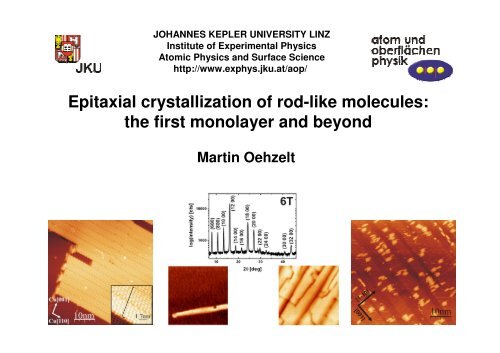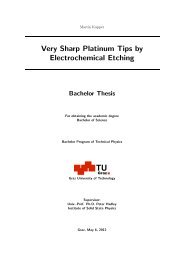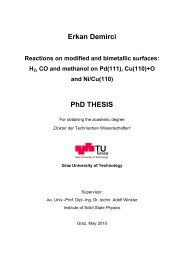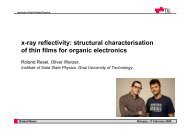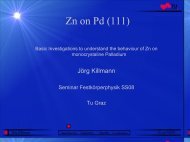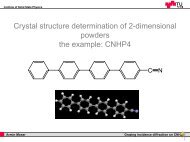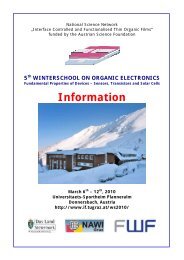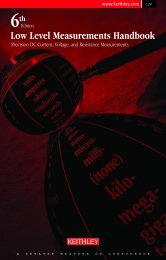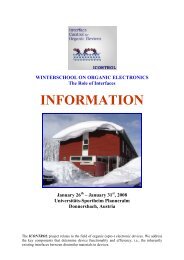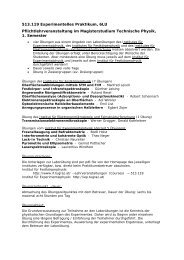6P on Cu(110)-(2x1)O
6P on Cu(110)-(2x1)O
6P on Cu(110)-(2x1)O
You also want an ePaper? Increase the reach of your titles
YUMPU automatically turns print PDFs into web optimized ePapers that Google loves.
JOHANNES KEPLER UNIVERSITY LINZ<br />
Institute of Experimental Physics<br />
Atomic Physics and Surface Science<br />
http://www.exphys.jku.at/aop/<br />
Epitaxial crystallizati<strong>on</strong> of rod-like molecules:<br />
the first m<strong>on</strong>olayer and bey<strong>on</strong>d<br />
Martin Oehzelt
Motivati<strong>on</strong>/Outlook<br />
Structure from the m<strong>on</strong>olayer up to thick layers<br />
- UHV is necessary for defined and reproducible studies<br />
- the substrate has a profound influence<br />
<strong>on</strong> the organic film:<br />
geometric structure (molecular orientati<strong>on</strong>)<br />
electr<strong>on</strong>ic structure<br />
device properties (band alignment)<br />
film morphology<br />
- the structure in the first m<strong>on</strong>olayer is the template<br />
for the growth of thicker films
Overview<br />
sexiphenyl (<str<strong>on</strong>g>6P</str<strong>on</strong>g>) first blue LEDs<br />
sexithiophene (6T) OFETs<br />
pentacene (5A) OFETs<br />
useful model molecules (clean and of<br />
technological relevance)<br />
can be evaporated in UHV<br />
molecules: evaporated in UHV<br />
substrates: single crystals<br />
<strong>Cu</strong>(<strong>110</strong>), <strong>Cu</strong>(<strong>110</strong>)-(<strong>2x1</strong>)O, Ag(<strong>110</strong>), …<br />
in-situ: STM, GI-XRD, PEEM, LEED, ARUPS,<br />
XPS, NEXAFS, RDS, …<br />
ex-situ: XRD, AFM, FM
3D-Structure<br />
- low symmetry m<strong>on</strong>oclinic<br />
or triclinic<br />
- layered herring-b<strong>on</strong>e<br />
structure
<str<strong>on</strong>g>6P</str<strong>on</strong>g> <strong>on</strong> <strong>Cu</strong>(<strong>110</strong>)<br />
reminiscent of a „smectic“ order with<br />
typical distances of 10.2 Å x 30-33 Å<br />
FT<br />
ARUPS<br />
ARUPS:<br />
„backd<strong>on</strong>ati<strong>on</strong>“ repulsive intermolecular<br />
interacti<strong>on</strong><br />
loosely packed m<strong>on</strong>olayer<br />
large molecular footprint!<br />
<str<strong>on</strong>g>6P</str<strong>on</strong>g> covers copper at ∼ 3-4 Å<br />
molecules are lying flat <strong>on</strong> the surface<br />
STM at RT:<br />
low order between molecular rows
<str<strong>on</strong>g>6P</str<strong>on</strong>g> <strong>on</strong> <strong>Cu</strong>(<strong>110</strong>)-(<strong>2x1</strong>)O: surface structure<br />
LT-STM at ~ 10K<br />
- oriented in [001]<br />
directi<strong>on</strong><br />
- molecules are<br />
densely packed<br />
~ 5 x 54 Å<br />
rectangular surface<br />
unit cell with<br />
two molecules<br />
VdW dimensi<strong>on</strong>s <str<strong>on</strong>g>6P</str<strong>on</strong>g>:<br />
~ 28.7 x 5.9 Å
<str<strong>on</strong>g>6P</str<strong>on</strong>g> <strong>on</strong> <strong>Cu</strong>(<strong>110</strong>)-(<strong>2x1</strong>)O: bulk structure<br />
Intensity a.u.<br />
XRD<br />
300 <str<strong>on</strong>g>6P</str<strong>on</strong>g> (20-3)<br />
250<br />
200<br />
150 <strong>Cu</strong>(220) HH<br />
100<br />
50<br />
- bulk crystallites have a<br />
(20-3) orientati<strong>on</strong><br />
0<br />
0,6 0,8 1,0 1,2 1,4 1,6 1,8 2,0 2,2<br />
Scattering vector s
<str<strong>on</strong>g>6P</str<strong>on</strong>g> <strong>on</strong> <strong>Cu</strong>(<strong>110</strong>)-(<strong>2x1</strong>)O: bulk structure<br />
XRD – pole figure<br />
- bulk crystallites have a<br />
(20-3) orientati<strong>on</strong><br />
- all molecules are<br />
oriented in <strong>Cu</strong>[001]<br />
directi<strong>on</strong><br />
<strong>Cu</strong>[001]
<str<strong>on</strong>g>6P</str<strong>on</strong>g> <strong>on</strong> <strong>Cu</strong>(<strong>110</strong>)-(<strong>2x1</strong>)O<br />
STM: <str<strong>on</strong>g>6P</str<strong>on</strong>g> overlayer: 5.1 Å x 54.1 Å<br />
XRD: <str<strong>on</strong>g>6P</str<strong>on</strong>g> (20-3) bulk: 5.66 Å x 54.6 Å<br />
mismatch: -8.4% x -1.1% !!<br />
tilting to release stress
<str<strong>on</strong>g>6P</str<strong>on</strong>g> <strong>on</strong> <strong>Cu</strong>(<strong>110</strong>)-(<strong>2x1</strong>)O<br />
NEXAFS<br />
surface structure<br />
<str<strong>on</strong>g>6P</str<strong>on</strong>g> (20-3)
6T <strong>on</strong> <strong>Cu</strong>(<strong>110</strong>)-(<strong>2x1</strong>)O<br />
STM at RT<br />
- molecules oriented<br />
in [001] directi<strong>on</strong><br />
- molecules are densely<br />
packed<br />
~ 5 x 27 Å<br />
rectangular unit cell<br />
not present<br />
in the bulk structure
6T <strong>on</strong> <strong>Cu</strong>(<strong>110</strong>)-(<strong>2x1</strong>)O: bulk structure<br />
XRD – pole figure<br />
- bulk crystallites have a<br />
(010) orientati<strong>on</strong><br />
- all molecules are oriented<br />
in [001] directi<strong>on</strong><br />
highly ordered<br />
GIXRD<br />
6T(100)<br />
6T(010)
Details of the structure <strong>on</strong> <strong>Cu</strong>(<strong>110</strong>)-(<strong>2x1</strong>)O<br />
NEXAFS data show<br />
again that the<br />
molecules can tilt<br />
to release stress
Heterostructures<br />
<str<strong>on</strong>g>6P</str<strong>on</strong>g> <strong>on</strong> 6T<br />
6T <strong>on</strong> <str<strong>on</strong>g>6P</str<strong>on</strong>g><br />
<str<strong>on</strong>g>6P</str<strong>on</strong>g>(20-3) <strong>on</strong><br />
6T(010) <strong>on</strong><br />
<strong>Cu</strong>(<strong>110</strong>)-(<strong>2x1</strong>)O<br />
6T(010) <strong>on</strong><br />
<str<strong>on</strong>g>6P</str<strong>on</strong>g> (20-3) <strong>on</strong><br />
<strong>Cu</strong>(<strong>110</strong>)-(<strong>2x1</strong>)O
Heterostructures<br />
6T <strong>on</strong> <str<strong>on</strong>g>6P</str<strong>on</strong>g><br />
Heterostructures of rod-like molecules orient their l<strong>on</strong>g<br />
molecular axes parallel to each other
Summary<br />
rod-like molecules can be oriented uniaxially through out<br />
the whole surface <strong>on</strong> substrate like <strong>Cu</strong>(<strong>110</strong>)-(<strong>2x1</strong>)O<br />
molecules have a certain degree of freedom to<br />
adjust to the surface and release stress<br />
highly oriented molecular films are suitable substrates<br />
for organic heterostructures<br />
with PEEM the growth of organic thin films can be<br />
studied in-situ and in real-time
Acknowledgements<br />
Johannes Kepler University Linz:<br />
Peter Zeppenfeld<br />
Lid<strong>on</strong>g Sun<br />
Günther Weidlinger<br />
Thorsten Wagner<br />
Michael Hohage<br />
Karl-Franzens University Graz:<br />
Michael G. Ramsey<br />
Georg Koller<br />
Stephen Berkebile<br />
Alexander Fleming<br />
University of Technology Graz:<br />
Roland Resel<br />
Markus Koini<br />
Thomas Haber<br />
Free University Berlin:<br />
Le<strong>on</strong>hard Grill


